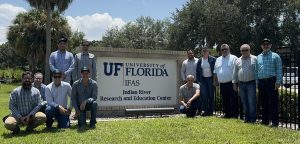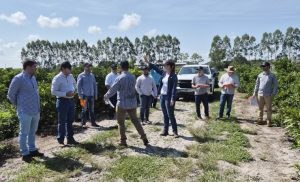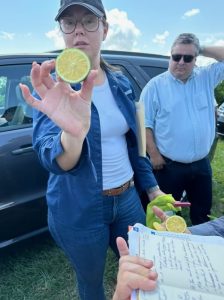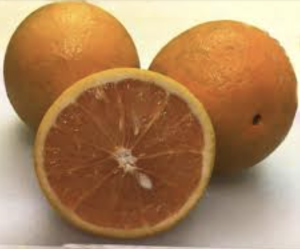FORT PIERCE, Fla.—Dr. Flavia Zambon recently hosted guests from her native Brazil’s São Paulo State, one of the world’s most prominent citrus production regions.
Brazilian citrus industry stakeholders visit the Indian River citrus production region
The visitors toured the Indian River Region to examine the management of huanglongbing, also known as HLB.

“At the traditional production region known as the Brazilian Citrus belt, HLB is reaching over 70% of incidence,” said Flavia Zambon, assistant professor of horticultural production at the UF/IFAS Indian River Research and Education Center (IRREC) in Fort Pierce. “The Brazilian producers look to UF/IFAS researchers and producers to plan their own HLB management strategies.”

Brazilian consultants arranged a multi-day statewide tour
Gilberto Tozatti, Hamilton Rocha, and Jeferson Pereira were the three consultants for the GCONCI (Grupo de Consultores em Citros), which organized the multi-day statewide visit in Florida. Joining the consultants were a farm director, two members of the citrus distribution system and six citrus growers many of whom are citrus industry veterans, said Zambon.
The tour included Dr. Flavia Zambon’s Citrus Horticulture Production Laboratory at IRREC
The visitors toured the UF/IFAS Citrus Horticulture Production Laboratory at IRREC and met with Indian River Citrus League Executive Vice President and General Manager, Doug Bournique, about the league’s perspective and future expectations of the industry. The group then visited the variety trials at the IRREC Millennium Block and a prominent local commercial citrus grove.
“The Brazilian growers are to expand their citrus operations to other areas outside São Paulo State, such as Mato Grosso, Minas Gerais, Bahia, and Paraná, where HLB incidence is lower, and there is land to be used,” Zambon said. “This exodus to other states will bring discussion on incorporating HLB management strategies into Brazil’s production groves.”
At the Millennium Block, visitors sampled ‘Glenn Navel’ oranges, which were not ready to harvest but were surprisingly good for Brazilian standards. The group also saw fruit development of some of the new grapefruit varieties, Zambon said.

“Some of the growers never saw a grapefruit, as it is not consumed in Brazil as it is here in the United States,” said Zambon.
During the visit to Scott Groves, the Brazilian group met with owner Ken Scott, who greeted them at his family’s operation. Scott Groves, Inc. Production Manager, and former UF/IFAS researcher Kevin Hancock escorted the visitors through the groves.
The visitors sampled OLL sweet oranges, developed by UF/IFAS plant breeders
“Kevin Hancock showed our guests the OLL sweet oranges, developed from the UF/IFAS citrus breeding program, lemons, other grapefruit varieties and explained the citrus industry from a grower standpoint,” said Zambon.

“One of the intentions of the growers’ visit to Florida and the Indian River Region was to learn and see new strategies to manage HLB and open possibilities for research collaboration with our scientists,” said Zambon. “The Brazilian citrus reality is turning into what we’ve seen in Florida for years. The Brazilian guests saw first-hand the most recent results of the horticultural research with the multiple HLB-infected combinations at the Millennium Block and commercial grove management strategies at Scott Groves.”
 6
6
